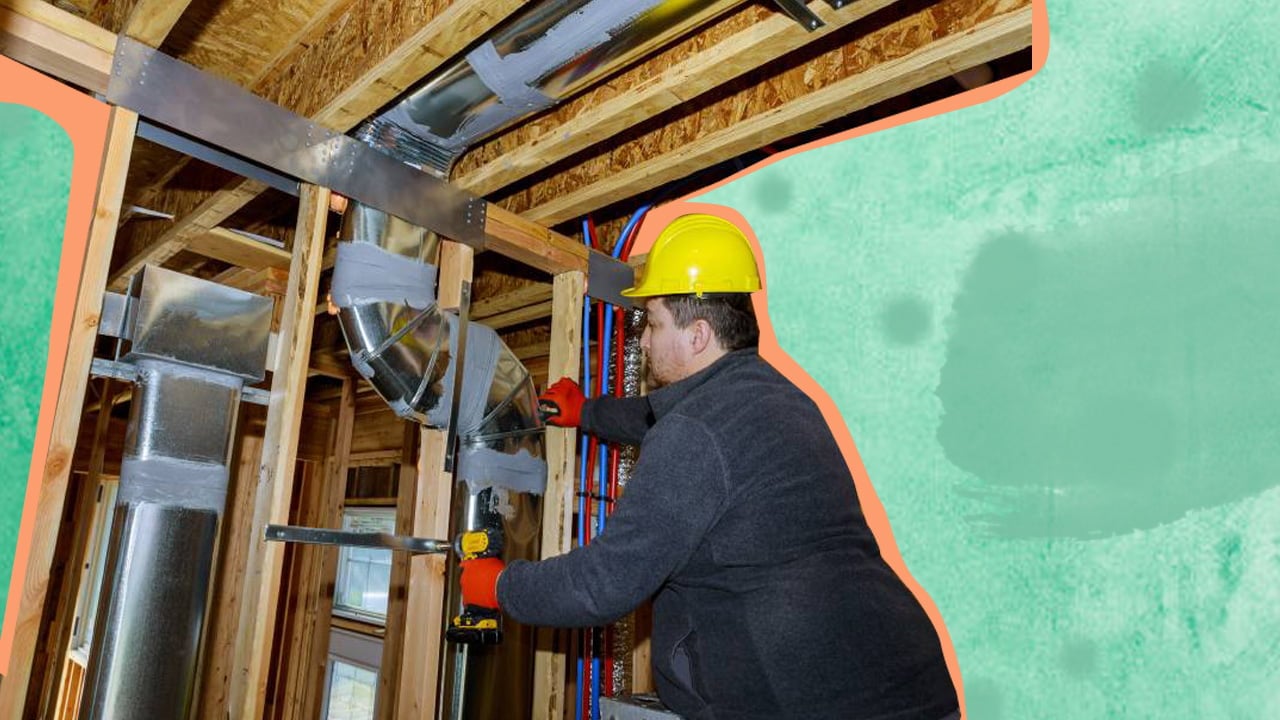What Size Duct Do I Need For A 12×12 Room? | A Detailed Guide
Both heating and cooling units have a system of ducts, known as ductwork that carry cool air to your room. Varying room sizes require different duct sizes, proving crucial for proper ventilation and functioning of HVAC systems. Ductwork can be quite tricky to get the hang of, especially if you’re not well-versed with HVAC systems. […]

Both heating and cooling units have a system of ducts, known as ductwork that carry cool air to your room. Varying room sizes require different duct sizes, proving crucial for proper ventilation and functioning of HVAC systems.
Ductwork can be quite tricky to get the hang of, especially if you’re not well-versed with HVAC systems. However, these metal tubes are critical for adequately heating and cooling your home, optimizing airflow in any space.
Once I familiarize you with some common duct-related terms, let’s look at what size ducts are required for a 12 x 12 room.
Where To Start The Ductwork Revolution?

Some rooms in your home are always too cold or hot, irrespective of what you do to balance out the temperature. This is mainly because several homes may have aging heating and cooling systems, for which you must refurbish the existing size of ductwork.
Determining duct size for every room in your home is generally the best solution for issues regarding:
- Heating
- Air conditioner (HVAC system), and
- Ventilation
But for enhanced functionality of these units, let’s find out how you can take the right measurements.
Important Terminology
Firstly, what is ductwork? Ductwork is the system of ducts that carry air from heating, ventilation, and air conditioning (HVAC system) units throughout the house. For well-functioning equipment, correctly installed and maintained ductwork is an absolute necessity.
But what do you mean by ducts, and how do they differ from ductwork? A duct can be classified as an individual synthetic or metal pipe, passage, conduit or tube used in ventilation, heating ducts, and air conditioning systems to remove or deliver air. These tubes promote air flow, exhaust air and form part of air return ducts.
To measure airflow volume, I generally use CFM or cubic foot per minute. This measures the air flow velocity each minute the air moves. For instance, if the air compressor has an output rating of 30 CFM, it indicates 30 cubic feet of air flow through the system each minute.
Generally, you will need at least 400 CFM for a 1 ton air conditioner.
Yet another term that you must know is BTU or British Thermal Units. BTU is an international energy measurement that indicates heat required to raise the temperature of one pound of water by one degree Fahrenheit. For residential air conditioning systems, BTU calculates how much heat the device can push out of the room each hour.
How To Calculate Duct Sizing For A Room
To accurately calculate the HVAC duct sizing needed for a room, you would need to know the rate of air flow as well as the overall size of the room. Additionally, knowing the square footage of your entire house can be beneficial since it what air conditioning unit you need.
To determine the airflow volume, you must know its Cubic Feet per Minute measurement. Airflow volume refers to the amount of air flowing through in a minute. An ideal way to measure it is by calculating the square footage since every square feet generally requires 1 CFM of airflow.
For a room with 400 CFM, you may only require a 4-inch duct but it is possible to go with a larger product if required. However, a large duct can be quite impractical, unless the room has a CFM that is over 400 but under 600. Most importantly, a lack of proper-sized ducts can make the airflow extremely loud and disturbing.
How Many CFM Is A 12 x 12 Duct?
For a room that measures 12 x 12, you will need a CFM of at least 144. This also calls for a supply duct size of 4 x 8 regardless of whether the CFM is 1 or 1 ¼ per square foot. For a room that is sized 144 square feet, this is the ideal size to ensure adequate airflow, be it for a cooling or heating system.
If you get a HVAC duct that is too large, it can affect the heating and cooling efficiency of the HVAC system. This is because larger ducts take longer to supply air for a relatively small room. On the contrary, opting for a duct smaller than the required size can result in a lack of proper airflow.
For instance, with a 3 x 6 size duct, airflow will be loud, while affecting circulation throughout the room. When the duct is too small, the air within has trouble leaving the HVAC unit.
On average, the installation charge for a 4 x 8 duct is $3,225. However, costs may vary depending on your home’s square footage, the HVAC equipment layout, and how easily it can be accessed.
What Size Duct Do I Need For A 200 Sq. Ft Room
For a room that is 200 square feet, you would need a HVAC duct size of 8 inches for proper airflow. In addition to 200 square feet, an 8-inch duct would also be ideal for rooms between 180 and 244 square feet. This ensures there is optimal airflow regardless of whether the room has windows.
At certain times, a room that has way too many windows can negatively affect the CFM and make calculations more difficult. Windows usually allow air to escape from the room, especially if they are not sealed properly or left open.
The general rule of 1 CFM (cubic feet per minute) per square footage can’t apply to a room with several windows or poorly sealed windows. In this scenario, you may switch the rule to 1 ¼ CFM per square foot.
However, this issue would not be as prominent in a 200 square feet room and adding an 8-inch duct to these rooms can improve the airflow for greater comfort.

Factors To Consider Before Calculating Duct Size
Before you begin calculating the right size duct needed for your room, you will have to take these factors into consideration. They are:
1. Size Of The Room
The first and foremost thing to consider is the overall square footage of the area in your home. This allows you to understand how big or small your air conditioner has to be.
To calculate the total square footage of your home, measure the width and length of all the rooms and add it all together. Having an idea about the total square feet of each separate room in your home can also be useful in understanding the ductwork required for each room.
2. CFM Velocity
Each room in your home will have a particular velocity at which the air needs to be delivered from the ducts in order to cool or heat the space.
To better understand this concept, let me take it step by step. As you know, every room has a maximum velocity CFM measurement which directly corresponds to the required duct size. You also know, as a rule of thumb, that it takes around 1 CFM of air in order to cool down a floor area of 1 square foot.
But how can you calculate the maximum velocity for each room? An easy way to do this is using the 1 CFM per square foot method. If you have more than one window in the room, take the measurement as 2 CFM or 1 ¼ CFM per square foot.
With this in mind, if you want to calculate the cubic feet per min (CFM) velocity for a 100-square-foot space, the CFM required will be 100.
3. Duct Friction Loss
A duct, much like other materials, has some amount of duct friction, which causes the air moving through it to lose its speed and energy. The longer the path the air has to move through, and the more turns it takes, the slower it comes out of the vent. It is recommended that you call an experienced HVAC contractor to deal with this situation and provide a quick solution.
How Many Ducts Are Needed Per Room?
The answer to this question is entirely subjective, as there is no strict rule regarding the right ductwork sizing for a room. However, having more than one duct certainly results in improved airflow velocity throughout the room. As long as the duct is sized appropriately and has the right CFM requirements, extra ventilation is never bad.
Having multiple ducts unnecessarily can result in your HVAC system being damaged, which then results in expensive repairs. The coils within your air conditioner can also end up freezing if there are too many air ducts. Frozen coils, in turn, damage the unit’s compressor and is usually quite expensive to repair.
Tip
A room that is sized 100 square feet or slightly bigger can find it useful to have around 2-3 ducts for optimized airflow. However, if the room is smaller than 100 square feet, installing multiple ducts can be an overkill, which makes the extra airflow uncomfortable.
Final Words
To summarize the aforementioned points, a 12 x 12 room would need a duct size of 4 x 8 for optimal airflow. This allows the air to move freely within the AC or heater without causing too much noise or affecting airflow quality.
Since a smaller duct can be harmful to the air conditioning HVAC unit and a larger duct can make airflow less efficient, getting the proper duct size for your room is crucial. Keep in mind to maintain your duct regularly to ensure they function properly and use a duct calculator to find the proper size. On average, air ducts need to be cleaned every four years to prevent duct damage as well as respiratory problems due to duct runs.

